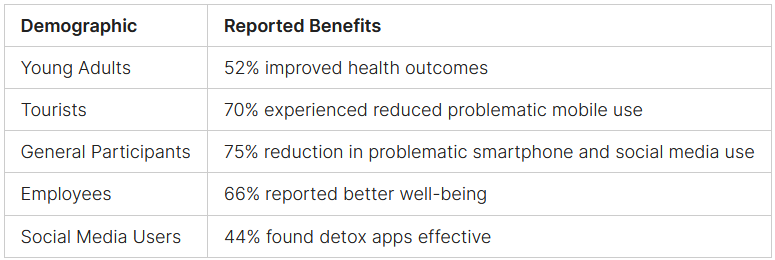Top 10 Digital Detox Tips for a Healthier Mind and Body
Have you ever thought about how your screen time affects your health? The American Psychological Association reports that nearly one-fifth of us feel stressed by technology. Meanwhile, 43% say they're always online, checking emails and social media.
Excessive screen time is not only mentally stressful but also harms us physically. For instance, teens spend about nine hours daily on screens. This can cause problems like headaches and blurred vision.
To address these issues, many experts, including Dr. Greenfield from the University of Connecticut, suggest a digital detox. It involves spending less time on screens. But remember, it's about balance, not complete cutting out of technology.
Practicing the 20-20-20 rule is one way to achieve this balance. It means looking away from screens every 20 minutes to relax your eyes. These small, mindful breaks can significantly reduce screen time. They can also improve how you sleep and communicate with others.
If you find it hard to detox alone, doing it with a friend or joining a digital detox retreat could help. These activities encourage finding joy in simple things like reading a book or conversing without distractions.
Understanding Digital Detox
In today's world, where smartphones and constant internet access are the norm, digital detox is crucial. This practice cuts down on device use to combat the negative effects of being always online. Such effects can lead to stress, lack of sleep, anxiety, and feeling constantly connected.
What is Digital Detox?
Digital detox involves consciously reducing how much we rely on our electronic devices. It's a way to protect our mental health from the downsides of modern technology. With U.S. adults spending about 11 hours daily on media, it's clear we need to learn how to step back.
Most people feel a strong urge to check their phones often, showing signs of a dependence on digital updates. This urge often stems from a fear of missing out if they're not online.
The Impact of Technology on Our Lives
The impact of technology overuse cannot be overstated. It leads to high stress and anxiety if devices are absent, affecting the majority of people. Sleep patterns are also disrupted for many, causing a decrease in sleep quality. After using social media, a large percentage of users feel negative emotions, with some even preferring online interactions to those in person.
However, the benefits of a digital detox are significant. For instance, 80% of people feel less stressed after cutting down on digital use. Also, 75% experience an improvement in focus, and 70% find they sleep better. These findings demonstrate the value of taking breaks from digital devices and connecting more with the real world.
Studies have also shown that less screen time can help reduce depression and feelings of loneliness. Among teens, 50% feel addicted to their devices, and 78% check them at least once an hour. Heavy mobile usage in young adults is linked to more sleep issues and increased stress, highlighting the negative impact of excessive screen time.
With such evidence, it's clear that adopting digital detox methods is vital. By setting limits and using technology mindfully, we can improve our mental health and life satisfaction.
Set Clear Boundaries with Technology
Establishing specific times and areas without digital distractions is key for a successful digital detox. By setting aside moments free from technology, you reduce constant alerts. This effort enhances your focus and lowers stress levels.
Designate Tech-Free Times
Adding disconnect times to your schedule lessens your reliance on digital tools and boosts your health. For example, avoid screens during meals and before sleep to bolster family talks and sleep quality. Online, promoting positive interactions enhances mental health by encouraging respect and kindness. Plus, cutting out unneeded alerts diminishes disruptions and improves your time management.
Create Tech-Free Zones
Make certain areas in your home free from devices for better sleep and family bonding. Keep dining tables and bedrooms device-free to foster deeper conversations and create stronger bonds. Start your mornings without digital devices by using analog alarm clocks and non-digital routines. This prevents you from being lured into online activities at the beginning of your day, leading to a smoother start and a real break from technology, allowing you to focus on what truly matters.
Creating tech-free times and zones is pivotal in leading a successful digital detox. These steps promote a better blend of digital and real-world interactions, resulting in a more fulfilling life with improved well-being.
Limit Screen Time for Better Health
A striking 97% of Americans now possess a cell phone. The majority, 9 out of 10, have upgraded to a smartphone. Hence, the need to regulate your screen exposure cannot be ignored. Overuse of screens profoundly impacts your health, both physically and mentally. It causes sleep disturbances, elevates your stress levels, and contributes to various health issues.
Digital eye strain and the escalation of obesity rates among teenagers are clear outcomes of excessive screen time. Overindulgence in devices connects to a plethora of adverse effects. Users often report eye dryness, headaches, and issues like "text neck" and "smartphone thumb." Moreover, exposure to blue light and social media can disrupt sleep, heighten stress, and foster feelings of social insecurity.
Effects of Excessive Screen Time
Overusing screens has its consequences. In particular, it leads to discomfort such as dry eyes and headaches. These problems are often seen alongside conditions like "text neck" and "smartphone thumb." Sleep can also be affected by this habit, mainly due to blue light. Stress levels can rise significantly.
For younger people, the link between screen time and obesity is strong. This is due to the sedentariness it encourages. Feelings of anxiety and social inadequacy are also prominent, especially with the influence of social media.
Benefits of Reducing Screen Time
You can significantly improve your health by setting clear limits on-screen use. Deleting social media apps can reduce FOMO and limit social comparison. This, in turn, can be beneficial for your mental health.
Reducing screen time increases productivity. It allows for more focus on real-life activities and relationships. Tools that help monitor screen time can be handy. Creating places at home where screens are not allowed can also promote healthier interactions and relaxation.
The 20-20-20 rule is a good practice. It suggests taking a 20-second break to look at something 20 feet away, every 20 minutes of screen use. A holistic approach that includes setting boundaries and finding non-digital activities is essential. This approach reduces screen time effectively.
Lastly, acknowledging the downsides of too much screen time is key. Actively working to cut down on screen use is crucial for a healthy life. Practices like mindfulness and prioritizing real connections are powerful ways to reduce screen time. The secret is finding a good balance.
Create a Digital Detox Routine
Diving into a digital detox seems challenging at first. However, by setting achievable goals, you can establish a more balanced digital life. To initiate a detox, follow these tips.
Start with Small Steps
Slow and steady progress is the best way to start a successful digital detox. Initially, assign specific times for device use. For instance, restrict phone checking to only lunchtime or evenings. Opt for a non-digital alarm clock to avoid early morning social media scrolling.
Additionally, try signing out of your accounts, making mindless browsing less convenient. Aim for a digital detox lasting one to two days. Starting during weekends or breaks is usually more feasible.
Tools like Freedom and Off-Time can aid by blocking certain websites and apps. These apps, along with the aforementioned changes, are the foundations for a more digitally balanced life.
Identify Your Digital Triggers
Understanding what leads you to extensive device use is pivotal. Common triggers are excessive email and social media checking prompted by boredom or anxiety. Over 43% of individuals are constantly on their digital devices, according to the American Psychological Association.
Noticing peak phone usage times helps in formulating strategies to counter these impulses. For instance, if you use your phone too much while watching TV, keep it away to minimize scrolling. Tweaking notification settings is also beneficial; it reduces interruptions thereby lowering the urge to check your device frequently.
Meditation for 5 to 10 minutes daily can enhance mindfulness and stress management. This practice, paired with the identification and handling of digital triggers, fosters a better technological relationship.
Here's a table of some steps and tools to guide you in your digital detox:
Engage in Offline Activities
Offline pursuits help maintain a balanced life, contributing to both emotional and physical health. They serve as a break from the digital world, enriching our lives through varied activities that don't involve screens.
Physical Exercise
Exercise is a key way to step away from digital devices. Activities like jogging, swimming, or even a leisurely walk can boost your spirits and clear your thoughts. Being outside for activities like hiking can greatly improve your overall well-being. It reduces stress and helps you avoid potential health risks from excessive digital exposure.
Hobbies and Crafts
Engagement in hobbies that don't require screens can bring significant enrichment in life. Whether it's painting, knitting, or cooking, these activities relieve stress and increase mindfulness. Such hands-on activities can enhance your mental and cognitive health by offering a sensory experience. Gardening, for example, allows you to interact with nature and take a break from screens.
Setting aside specific times for these offline activities can effectively cleanse your digital life. Creating a space free of clutter supports this effort, ensuring you have a calm environment. It's also crucial to make clear rules for your digital detox, putting away devices to reduce temptations. Throughout this journey, remember to treat yourself with patience and kindness. Choosing hobbies that don't involve screens leads to a more balanced and fulfilling existence.
Practice Mindfulness and Meditation
Mindfulness and meditation bring comfort by helping us be present in each moment and understand our thoughts and surroundings. This reduces the stress from our constant use of digital devices. Practices like focused breathing and visualization bring peace away from screens, enhancing calmness and focus.
Benefits of Mindfulness
Mindfulness yields extensive benefits. Through daily practice, one can achieve heightened focus, lower stress, and better emotional equilibrium. A study found that 85% of participants felt more connected to their daily tasks after embracing mindfulness. Moreover, workplaces endorsing these techniques saw reductions in absenteeism by 30% and boosted productivity by 18%. These findings highlight mindfulness’ significant role in enhancing our lives.
Simple Meditation Techniques
Adopting basic meditation practices can lead to profound changes. One approach, mindful breathing, asks you to concentrate solely on your breath, keeping you grounded in the present. Studies reveal that after a mere few weeks, such exercises decreased perceived stress by a quarter. Another method, body scan meditation, guides you through relaxing each body part, thus easing tension. Daily inclusion of these methods in mindfulness routines improves stress management and mental well-being.
Reconnect with Nature
The most rejuvenating part of a digital detox is the opportunity to connect with nature. Being in natural environments is crucial for both mental and physical health. It improves mood and boosts overall vitality considerably.
Outdoor Activities
Participating in outdoor events like hiking, camping, or visiting the beach is a break from our digital lives. Evidently, 83% of those who travel think a break from technology allows a better connection with nature. These activities lower stress and let you absorb the healing power of nature.
A challenging hike or leisurely day at a lake can significantly increase creativity and energy. The absence of screens has a remarkable effect on personal well-being.
Importance of Nature Walks
Nature walks are exceptionally good at clearing the mind and reducing anxiety. Up to 68% of people see a decline in stress levels after nature-focused breaks. Walking in a park or woods helps you “ground” yourself, physically bonding with the earth. This process removes negative energy and reinforces our connection with our planet.
People are increasingly drawn to places with little to no digital distractions for their holidays. Some seek out the Faroe Islands or Bhutan for their minimal digital presence. These places are perfect for deep, restorative experiences in nature.
Review and Adjust Your Digital Detox Plan
Regularly review and adjust your digital detox plan for long-term success. By tracking your progress and asking for assistance when needed, you greatly support your way to a healthier online experience.
Track Your Progress
Keeping a journal or using apps to track your digital well-being is a powerful method. You can note changes in mood, sleep patterns, and social life. Such insights help you comprehend the benefits of a digital detox. For example, 52% of young adults improved their health after a two-week break from social media. After detox, 75% experienced less smartphone overuse, and 62% felt mentally better.
It's interesting to see how detox aids various groups:
Detoxing from digital life can be hard, especially alone. Reach out for support from loved ones or experts to maintain commitment. Involvement in community resources or therapy can offer essential tactics and keep you motivated. Almost 99% of those who tried staying away from smartphones noted improvements in mood, anxiety, and cravings.
Using digital detox apps is also beneficial. A study showed that 44% of young adults found these apps helpful in curbing smartphone misuse and boosting their mood. These apps provide plans and insights that aid in maintaining focus.
Understanding the concrete advantages, like uplifted mood and lower anxiety, underscores the importance of sticking to a thorough digital detox routine. It’s key to remain watchful. Keep in mind that the path to digital health and balance is an ongoing, beneficial one.
Final Thoughts
Doing a digital detox has transformed the lives of many. Studies indicate that 74% saw better mental health after cutting back on phone time, while 56% noted a reduction in anxiety and a lift in mood. These findings highlight the importance of a healthy tech-life balance.
Keeping track of your detox success and adjusting as needed is key to your personal growth. With 87% witnessing sharper mental focus and better clarity, the effort to control digital use pays off. Having support from friends or joining a detox group can make facing obstacles easier and strengthen your resolve to live better.
Transforming your break from screens into a triumph brings significant and enduring benefits. Anticipate improved sleep, deeper personal relationships, and an overall enhancement to your well-being. By adopting these methods, you secure continuous improvement in both mind and body.
Take care,
-Emilia ♡
Sources
Shopper, K. (2024, September 12). The power of digital detox. North Kansas City Hospital.
Friedman, D. (2025, January 26). A complete guide to a digital detox. Health.
Anandpara, G., Kharadi, A., Vidja, P., Chauhan, Y., Mahajan, S., & Patel, J. (2024). A comprehensive review on digital detox: a newer health and wellness trend in the current era. Cureus.
Lawler, M. (2025, February 26). How to do a digital detox. EverydayHealth.com.
Staff, N. A. (2024, July 17). How to help teens unplug. Newport Academy.
The Lanier Law Firm. (2025, March 3). Social Media Addiction Statistics - The Lanier Law firm.

















Why December hits so hard—think mental overload, holiday stress, and emotional burnout. Learn to reset, protect your energy, and step into the new year without running on empty.